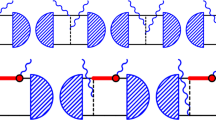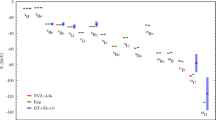Abstract
In this short review, I discuss the sensitivity of the generation of the light and the life-relevant elements such as carbon and oxygen under changes of the parameters of the Standard Model pertinent to nuclear physics. Chiral effective field theory allows for a systematic and precise description of the forces between two, three and four nucleons. In this framework, variations under the light quark masses and the electromagnetic fine-structure constant can also be consistently calculated. Combining chiral nuclear effective field theory with Monte Carlo simulations allows to further calculate the properties of nuclei, in particular of the Hoyle state in carbon, that plays a crucial role in the generation of the life-relevant elements in hot, old stars. The dependence of the triple-alpha process on the fundamental constants of nature is calculated, and some implications for our anthropic view of the Universe are discussed.
本文讨论了较轻的且和生命相关的元素, 例如碳元素和氧元素的产生对于跟核 物理相关的标准模型中的参数变化的敏感性. 手征有效场理论可以系统精确地 描述两核、三核以及四核之间的作用力, 同时可以计算其随轻夸克质量和电磁精 细结构常数的变化. 运用手征核有效场理论和蒙特卡罗模拟方法可以进一步计 算原子核的性质, 特别是碳原子的Hoyle 态, 该态在炽热远古星体产生与生命相 关元素的过程中起了重要作用. 另外, 文章讨论了3α 过程对自然界基本常数的 依赖性, 以及关于宇宙的人择观点的一些启示.








Similar content being viewed by others
Explore related subjects
Discover the latest articles, news and stories from top researchers in related subjects.Notes
Throughout this review, we work in two-flavor QCD with up and down quarks with masses \(m_u\) and \(m_d\), respectively. In most cases, it suffices to work in the isospin limit \(m_u = m_d \equiv m_q\), but at one instance we also have to consider strong isospin breaking with \(m_u \ne m_d\).
References
Jaffe RL, Jenkins A, Kimchi I (2009) Quark masses: an environmental impact statement. Phys Rev D 79:065014
Barnes LA (2011) The fine tuning of the universe for intelligent life. arXiv:1112.4647 [physics.hist-ph]
Schellekens AN (2013) Life at the interface of particle physics and string theory. Rev Mod Phys 85:1491
Carter B (1974) Large number coincidences and the anthropic principle. Confrontation of cosmological theories with observational data. Springer, Netherlands
Weinberg S (1987) Anthropic bound on the cosmological constant. Phys Rev Lett 59:2607
Susskind L (2003) The anthropic landscape of string theory. In: Carr B (ed) Universe or multiverse? Cambridge University Press, Cambridge, pp 247–266
Hoyle F (1954) On nuclear reactions occurring in very hot STARS. I. The synthesis of elements from carbon to nickel. Astrophys J Suppl Ser 1:121
Linde A (2007) The inflationary multiverse. In: Carr B (ed) Universe or multiverse? vol 1. Cambridge University Press, Cambridge, p 127
Kragh H (2010) An anthropic myth: Fred Hoyle’s carbon-12 resonance level. Arch Hist Exact Sci 64:721–751
Freer M, Fynbo HOU (2014) The Hoyle state in \(^{12}\)C. Prog Part Nucl Phys 78:1–23
Weinberg S (1990) Nuclear forces from chiral Lagrangians. Phys Lett B 251:288–292
Weinberg S (1991) Effective chiral Lagrangians for nucleon–pion interactions and nuclear forces. Nucl Phys B 363:3–18
Epelbaum E, Hammer HW, Meißner UG (2009) Modern theory of nuclear forces. Rev Mod Phys 81:1773
Ishikawa S, Robilotta MR (2007) Two-pion exchange three-nucleon potential: \(O(q^4)\) chiral expansion. Phys Rev C 76:014006
Bernard V, Epelbaum E, Krebs H et al (2008) Subleading contributions to the chiral three-nucleon force. I. Long-range terms. Phys Rev C 77:064004
Bernard V, Epelbaum E, Krebs H et al (2011) Subleading contributions to the chiral three-nucleon force II: short-range terms and relativistic corrections. Phys Rev C 84:054001
Krebs H, Gasparyan A, Epelbaum E (2012) Chiral three-nucleon force at N\(^4\)LO I: longest-range contributions. Phys Rev C 85:054006
Krebs H, Gasparyan A, Epelbaum E (2013) Chiral three-nucleon force at N\(^4\)LO II: intermediate-range contributions. Phys Rev C 87:054007
Machleidt R, Entem DR (2011) Chiral effective field theory and nuclear forces. Phys Rep 503:1–75
Epelbaum E, Glöckle W, Meißner UG (2005) The two-nucleon system at next-to-next-to-next-to-leading order. Nucl Phys A 747:362–424
Entem DR, Machleidt R (2003) Accurate charge-dependent nucleon–nucleon potential at fourth order of chiral perturbation theory. Phys Rev C 68:041001
Machleidt R (2001) The high precision, charge dependent Bonn nucleon–nucleon potential (CD-Bonn). Phys Rev C 63:024001
Gross F, Stadler A (2008) Covariant spectator theory of np scattering: phase shifts obtained from precision fits to data below 350-MeV. Phys Rev C 78:014005
Stoks VGJ, Kompl RAM, Rentmeester MCM et al (1993) Partial wave analysis of all nucleon–nucleon scattering data below 350-MeV. Phys Rev C 48:792
Borasoy B, Epelbaum E, Krebs H et al (2007) Lattice simulations for light nuclei: chiral effective field theory at leading order. Eur Phys J A 31:105–123
Lee D (2009) Lattice simulations for few- and many-body systems. Prog Part Nucl Phys 63:117–154
Epelbaum E, Krebs H, Lähde TA et al (2012) Structure and rotations of the Hoyle state. Phys Rev Lett 109:252501
Wigner E (1937) On the consequences of the symmetry of the nuclear Hamiltonian on the spectroscopy of nuclei. Phys Rev 51:106
Mehen T, Stewart IW, Wise MB (1999) Wigner symmetry in the limit of large scattering lengths. Phys Rev Lett 83:931
Chen JW, Lee D, Schaefer T (2004) Inequalities for light nuclei in the Wigner symmetry limit. Phys Rev Lett 93:242302
Lee D (2007) Spectral convexity for attractive SU(2\(N\)) fermions. Phys Rev Lett 98:182501
Pieper SC (2008) Quantum Monte Carlo calculations of light nuclei. Riv Nuovo Cim 31:709
Navratil P, Gueorguiev VG, Vary JP et al (2007) Structure of \(A=10-13\) nuclei with two plus three-nucleon interactions from chiral effective field theory. Phys Rev Lett 99:024501
Roth R, Langhammer J, Calci A et al (2011) Similarity-transformed chiral \(NN+3N\) interactions for the ab initio description of 12-C and 16-O. Phys Rev Lett 107:072501
Epelbaum E, Krebs H, Lee D et al (2011) Ab initio calculation of the Hoyle state. Phys Rev Lett 106:192501
Zimmerman WR, Ahmed MW, Bromberger B et al (2013) Unambiguous identification of the second \(2^+\) state in C\(^{12}\) and the structure of the Hoyle state. Phys Rev Lett 110:152502
Lähde TA, Epelbaum E, Krebs H et al (2014) Lattice effective field theory for medium-mass nuclei. Phys Lett B 732:110–115
Oberhummer H, Csoto A, Schlattl H (2000) Stellar production rates of carbon and its abundance in the universe. Science 289:88–90
Epelbaum E, Nogga A, Gloeckle W et al (2002) Three nucleon forces from chiral effective field theory. Phys Rev C 66:064001
Epelbaum E, Krebs H, Lee D et al (2009) Lattice chiral effective field theory with three-body interactions at next-to-next-to-leading order. Eur Phys J A 41:125–139
Colangelo G, Gasser J, Leutwyler H (2001) The quark condensate from \(K_{e_4}\) decays. Phys Rev Lett 86:5008
Berengut JC, Epelbaum E, Flambaum VV et al (2013) Varying the light quark mass: impact on the nuclear force and Big Bang nucleosynthesis. Phys Rev D 87:085018
Epelbaum E, Meißner UG, Gloeckle W et al (2002) Resonance saturation for four nucleon operators. Phys Rev C 65:044001
Müther H, Engelbrecht CA, Brown GE (1987) Nuclear physics in colorful worlds: quantumchromodynamics and nuclear binding. Nucl Phys A 462:701–726
Beane SR, Savage MJ (2003) Variation of fundamental couplings and nuclear forces. Nucl Phys A 713:148–164
Epelbaum E, Meißner UG, Gloeckle W (2003) Nuclear forces in the chiral limit. Nucl Phys A 714:535–574
Flambaum VV, Wiringa RB (2007) Dependence of nuclear binding on hadronic mass variation. Phys Rev C 76:054002
Soto J, Tarrus J (2012) On the quark mass dependence of nucleon–nucleon S-wave scattering lengths. Phys Rev C 85:044001
Yamazaki T et al [PACS-CS Collaboration] (2010) Helium nuclei in quenched lattice QCD. Phys Rev D 81:111504
Beane SR, Chang E, Cohen SD et al (2013) Light nuclei and hypernuclei from quantum chromodynamics in the limit of SU(3) flavor symmetry. Phys Rev D 87:034506
Epelbaum E, Krebs H, Lee D et al (2010) Lattice calculations for \(A= 3, 4, 6, 12\) nuclei using chiral effective field theory. Eur Phys J A 45:335–352
Bedaque PF, Luu T, Platter L (2011) Quark mass variation constraints from big bang nucleosynthesis. Phys Rev C 83:045803
Berengut JC, Flambaum VV, Dmitriev VF (2010) Effect of quark-mass variation on big bang nucleosynthesis. Phys Lett B 683:114–118
Damour T, Donoghue JF (2008) Constraints on the variability of quark masses from nuclear binding. Phys Rev D 78:014014
Borsanyi S, Dürr S, Fodor Z et al (2014) Ab initio calculation of the neutron–proton mass difference. arXiv:1406.4088 [hep-lat]
Epelbaum E, Krebs H, Lähde TA et al (2013) Viability of carbon-based life as a function of the light quark mass. Phys Rev Lett 110:112502
Epelbaum E, Krebs H, Lähde TA et al (2013) Dependence of the triple-alpha process on the fundamental constants of nature. Eur Phys J A 49:82
Livio M, Hollowell D, Weiss A et al (1989) The anthropic significance of the existence of an excited state of \(^{12}\)C. Nature 340:281–284
Weinberg S (2001) Facing up. Harvard University Press, Cambridge
Oberhummer H, Csótó A, Schlattl H (2001) Bridging the mass gaps at \(A=5\) and \(A=8\) in nucleosynthesis original. Nucl Phys A 689:269–279
Schlattl H, Heger A, Oberhummer H et al (2004) Sensitivity of the C and O production on the 3\(\alpha \) rate. Astrophys Space Sci 291:27–56
Rupak G, Lee D (2013) Radiative capture reactions in lattice effective field theory. Phys Rev Lett 111:032502
Pine M, Lee D, Rupak G (2013) Adiabatic projection method for scattering and reactions on the lattice. Eur Phys J A 49:151
Ubaldi L (2010) Effects of theta on the deuteron binding energy and the triple-alpha process. Phys Rev D 81:025011
Acknowledgments
I am grateful to Steve Weinberg, whose query on the resonance condition triggered part of the work done here. I would like to thank my NLEFT collaborators Evgeny Epelbaum, Hermann Krebs, Timo Lähde, Dean Lee and also Gautam Rupak for a most enjoyable collaboration. Some part of this work was done in collaboration with Julian Berengut, Victor Flambaum, Christoph Hanhart, Jenifer Nebreda and Jose Ramon Peláez. I would also like to thank Zhizhong Xing for giving me the opportunity to write this review. I am grateful to Evgeny Epelbaum, Dean Lee and Qiang Zhao for a careful reading of the manuscript. This work was supported in part by DFG and NSFC (Sino-German CRC 110), Helmholtz Association (contract VH-VI-417), BMBF (grant 05P12PDFTE), the EU (HadronPhysics3 project) and LENPIC (DEC-2103/10/M/ST2/00420). Computational resources provided by the Jülich Supercomputing Centre (JSC) at the Forschungszentrum Jülich and by RWTH Aachen.
Conflict of interest
The authors declare that they have no conflict of interest.
Author information
Authors and Affiliations
Corresponding author
Additional information
This review was invited by Professor Zhi-zhong Xing.
About this article
Cite this article
Meißner, UG. Anthropic considerations in nuclear physics. Sci. Bull. 60, 43–54 (2015). https://doi.org/10.1007/s11434-014-0670-2
Received:
Accepted:
Published:
Issue Date:
DOI: https://doi.org/10.1007/s11434-014-0670-2




